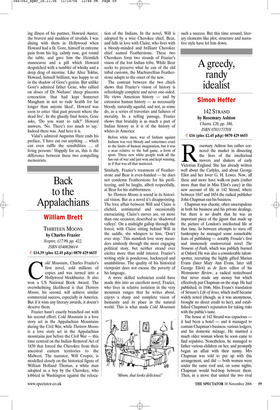A greedy, randy idealist
Simon Heffer
142 STRAND by Rosemary Ashton Chatto, £20, pp. 386, ISBN 070117370X ✆ £16 (plus £2.45 p&p) 0870 429 6655 Rosemary Ashton has rather cornered the market in dissecting the lives of the intellectual movers and shakers of early Victorian England. She has already written well about the Carlyles, and about George Eliot and her lover G. H. Lewes. Now, all these and more have walk-on parts (rather more than that in Miss Eliot’s case) in this new account of life at 142 Strand, where between 1847 and 1854 the radical publisher John Chapman ran his business.
Chapman was chaotic, often unscrupulous in both his business and his private dealings, but there is no doubt that he was an important piece of the jigsaw that made up the picture of London’s intellectual life at that time. In between attempts to stave off bankruptcy he managed some remarkable feats of publishing — notably Froude’s first and immensely controversial novel The Nemesis of Faith, which was publicly burned at Oxford. He was also a considerable talentspotter, recruiting the highly gifted Marian Evans (later Mary Ann Evans, later still George Eliot) as de facto editor of his Westminster Review, a radical noticeboard that never made any money but which effectively put Chapman on the map. He had published, in 1846, Miss Evans’s translation of Strauss’s Life of Jesus, which itself became widely noted (though, as it was anonymous, brought no direct credit to her), and established Chapman’s reputation for taking risks with the public’s taste.
The house at 142 Strand was capacious it had been a hotel — and it managed to contain Chapman’s business, various lodgers, and his domestic ménage. He married a much older woman whom he soon came to find repulsive. Nonetheless, he managed to father various children on her, and promptly began an affair with their nanny. Mrs Chapman was told to put up with this arrangement, and did — both women were under the same roof and, on some nights, Chapman would bed-hop between them. Then, in a move that united the two rival women, Miss Evans turned up as a lodger while doing business for Chapman. He appears to have had carnal knowledge of her too, and her obvious interest to him more cerebral than physical, it must be emphasised — was enough to ensure that he had a rebellion on his hands. Miss Eliot was dispatched back to the Midlands, and in time went off to Germany with Lewes, a married man. Any notions one still retained about the propriety of the middle classes in Victorian England are easily dismissed by reading this book.
Chapman flew by the seat of his pants for most of his career, raising money from backers on dubious pretexts, in a world where copyright (especially where it concerned overseas authors) was not so clearcut as it is today. Nonetheless, he performed an invaluable service in seeing into print works that too many other publishers would not touch with a bargepole — not on account of their quality, but because of the dubious taste of their subject matter and the likelihood of their being rejected by a bootfaced mainstream. Froude was but one example of this. Chapman also published Carlyle’s incendiary Latter-Day Pamphlets, which even in 1850 drew gasps of horror at what appeared to be his racism and advocacy of brutality against troublemakers. He also gave a platform, in the Westminster Review, to T. H. Huxley, who styled himself ‘Darwin’s bulldog’.
Chapman, who seems to have been both greedy for money (hardly surprising as, acording to the author’s account of him, he so rarely had any) and idealistic, did a great service to minority voices. It is not merely his championship of radical, nonconformist causes that makes him important in his era. It is also his advancement of women writers, such as Harriet Martineau and Barbara Leigh Smith,even if, in some cases, that support was accompanied by a pressing need to join them in their boudoirs. He also helped bring Ralph Waldo Emerson’s works to a wider British public, and used 142 Strand to host regular soirées at which the literati, and would-be literati, could meet each other.
In the end, publishing proved not to be the making of Chapman’s fortune. He qualified as a doctor (his brother, too, had been one), and it seems perfectly normal that he should have taken a special interest in improving the medical treatment of women, notably by the use of chloroform during childbirth. Rosemary Ashton tells his story — and, more to the point, the story of his house, business and ménage — with both aplomb and scholarship. Anyone wanting to deepen their knowledge of London’s intellectual life at this time will find her book indispensable.



































































































 Previous page
Previous page